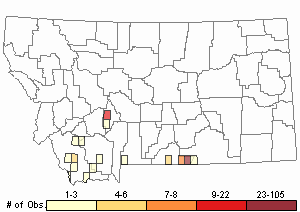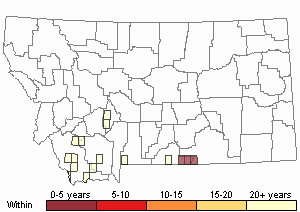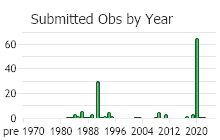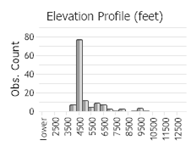View in other NatureServe Network Field Guides
NatureServe
Montana
Utah
Wyoming
Idaho
Wisconsin
British Columbia
South Carolina
Yukon
California
New York
Sword Townsend-daisy - Townsendia spathulata
State Rank Reason (see State Rank above)
Sword Townsend-daisy occurs in limestone areas of southwest and south-central Montana. Overall, the species' viability in the state does not appear to be at risk due in part to its relatively widespread distribution and its overall abundance. The population in the Limestone Hills in Broadwater County may be negatively impacted by proposed mine expansion and military activities.
General Description
PLANTS: A low-growing perennial that forms dense mats (cushions). Highly branched woody stems arise from a taproot. Stems are closely spaced, short, and terminate in individual rosettes. Sources: Lesica et al. 2012; Giblin et al. (eds) 2018; Strother in Flora of North America [FNA] 2006.
LEAVES: Narrowly oblong to spatulate (spoon-shaped), 5-10 mm long by 1.5-2 mm wide, and both basal and cauline on short stems of less than 1 cm long. Foliage is covered in dense, long, soft, crooked hairs that are also matted (wooly) and unmatted (villous). Sources: Lesica et al. 2012; Giblin et al. (eds) 2018; Strother in FNA 2006.
INFLORESCENCE: Flowers are arranged in radiate heads (with both ray and disc florets). Ray florets, with white to pinkish strap-like petals (ligules), surround a cluster of yellow disk florets. Heads are singular to many and nearly stemless. The involucre of the flower head is broadly campanulate (bell-shaped), 6-10 mm high by 6-12 mm wide. Each involucral bract (phyllary) is pointed, narrow, imbricate (overlapping), covered with villous hairs, and 5-8 mm long. Ray florets are 12 to 30 (or more) in number and 4-10 mm long. Disk florets are 16 to 30 (or more) in number, 4-7 mm long, and often shorter than the pappus. The pappus is a single row of rigid, narrow, barbed, bristle-like scales which are connate at the base. Sources: Lesica et al. 2012; Giblin et al. (eds) 2018; Strother in FNA 2006.
Townsendia is named for David Townsend (1787-1858), an amateur botanist who lived in West Chester, Pennsylvania. Spathulata refers to spoon-shaped leaves.
Phenology
Flowering early May to late June. Plants flower and disperse fruit in a two-four week period.
Diagnostic Characteristics
Montana has nine
Townsendia species. In general
Townsendia spathulata most closely resembles
Townsendia condensata, with its name having been misapplied to the latter. The following
Townsendia species have stems obscured by leaves and flowers, are perennial, and usually have a woody branched caudex, but can be separated by a combination of these characteristics:
Sword Townsendia –
Townsendia spathulata, SOC
*Leaves: Wooly to villous (long, soft, crooked hairs that can be matted and unmatted); Spoon-shaped except in Broadwater County where leaves are nearly linear. 5-10 mm long.
*Flowers: Heads are nearly stemless. Involucre is 6-10 mm high. Involucral bracts are villous and have acute tips except in Broadwater County where they are sparsely strigose. Ray florets have off-white or pinkish petals, 4-10 mm long.
*Habitat: Grows on limestone derived soils from low elevations to alpine.
Cushion Townsend-daisy–
Townsendia condensata, SOC
*Leaves: Villous, spoon-shaped, and 5-20 mm long.
*Flowers: Heads are nearly stemless. Involucre is 10-25 mm high. Ray florets have pink petals that dry to lavender, 6-15 mm long.
*Habitat: Found at and above timberline (subalpine/alpine).
Slender Townsend-daisy –
Townsendia leptotes, Status Under Review
*Leaves:
Sparsely strigose (stiff, straight, sharp,
and appressed hairs). Linear to oblong in shape, and 12-25 mm long.
*Flowers: Heads usually sessile. Involucre is 8-12 mm high. Ray florets have white to pinkish petals.
*Habitat: Rocky ridges and sandy slopes.
Hooker’s Townsend-daisy –
Townsendia hookeri*Leaves:
Densely strigose. Linear to oblanceolate in shape, 5-30 mm long.
*Flowers: The involucre is 7-12 mm high. Involucral bracts have ciliate margins and
are tipped with a tuft of hairs (cilia). Ray florets have white to pink petals.
*Habitat: Occurs in grasslands, sagebrush steppe, and woodlands at lower elevations.
Silky Townsend-daisy –
Townsendia exscapa*Leaves: Strigose. Linear to oblanceolate in shape, 10-40 mm long.
*Flowers: The involucre is 12-20 mm high. Involucral bracts have ciliate margins and
are not tipped with a tuft of hairs (cilia). Ray florets have white to pink petals.
*Habitat: Occurs in grasslands and sagebrush steppe at lower elevations.
Hoary Townsend-daisy –
Townsendia incana*Leaves: Densely strigose. Linear in shape, 10-20 mm long.
*Flowers: Heads have peduncles of 3-40 mm long that grow from leafy stems of 1-3 cm long. The involucre is 6-9 mm high. Ray florets have pinkish petals.
*Fruits: Achenes are hairy.
*Habitat: Grows on sandy calcareous soil of grasslands, sagebrush steppe, and woodlands at lower elevations.
Wyoming Townsend-daisy –
Townsendia montana*Leaves: Strigose. Leaves are oblong to spatulate in shape, 10-30 mm long.
*Flowers: Heads have peduncles of 3-40 mm long that grow from leafy stems of about 1 cm long. Involucre is 6-11 mm high. Ray florets have blue petals.
*Fruits: Achenes typically lack hairs (glabrous).
*Habitat: Grows on stony, usually calcareous soils of fellfields and meadows in the alpine-subalpine zone.
Species Range
Montana Range
Range Descriptions

 Native
Native
Range Comments
First described by Thomas Nuttall (1840 - 1841), Sword Townsend-daisy is a regional endemic, only growing in southwest and south-central Montana and in western and central Wyoming (Lee 2007; https://wyndd.org/data_explorer.php 2021).
Observations in Montana Natural Heritage Program Database
Number of Observations: 163
(Click on the following maps and charts to see full sized version)
Map Help and Descriptions
Relative Density

Recency



 (Observations spanning multiple months or years are excluded from time charts)
(Observations spanning multiple months or years are excluded from time charts)
Habitat
Sword Townsend-daisy grows in open, rocky, limestone-derived soils of slopes and windswept ridgetops. West of the Continental Divide, it is found mainly in alpine cushion plant communities as high as 9,000-10,000 feet in elevation. East of the Continental Divide it is found at lower elevations (as low as 4,000 feet) in foothills, grasslands, cushion plant grasslands, mountain mahogany woodlands, and limber pine woodlands, (Lesica et al. 2012;
www.pnwherbaria.org).
Ecology
ASSOCIATED SPECIESIn alpine areas, Sword Townsend-daisy is associated with other cushion and low growing plants including as Alpine Forget-me-not (
Eritrichium nanum), Oval-leaved Buckwheat (
Eriogonum ovalifolium), Snow Spring-parsley (
Cymopterus nivalis), Few-seed Whitlow-grass (
Draba oligosperma), Hare's-foot Locoweed (
Oxytropis lagopus), Alpine Stitchwort (
Minuartia obtusiloba), and Cut-leaf Fleabane (
Erigeron compositus).
At lower elevations associated species include Black Sagebrush (
Artemisia nova), Curl-leaf Mountain-mahogany (
Cercocarpus ledifolius), Howard’s Forget-me-not (
Eritrichium howardii), Common Twinpod (
Physaria didymocarpa), Stemless Four-nerve-daisy (
Hymenoxys acaulis), Torrey Bitterweed (
Hymenoxys torreyana), and various Phlox species (
www.pnwherbaria.org; Lesica et al. 1986).
Reproductive Characteristics
Asteraceae – Sunflower Family
Members of the Asteraceae family bear their flowers in dense flowering heads. Each flowering head is subtended by an involucre made of bracts or phyllaries which can be numerous to few and overlapping to uniseriate. Each head is comprised of few to many tiny flowers or ‘florets’ which are closely arranged and attached directly to a common receptacle (a flattened, convex, or connate disc). The ‘ray’ florets, which have a strap-like petal (ligule), arise from the outer edge of the disc, giving the appearance that each floret is an individual petal of the flowering head. The center of the receptacle is crowded with ‘disc’ florets which have tiny corollas usually visible only with magnification. Some species in Asteraceae have flowering heads comprised only of ray florets (ligulate), while other species in the family have heads solely of disc florets (discoid). Most species, however, have both ray and disc flowers (radiate) giving the appearance of a daisy or sunflower. The individual florets are unisexual or can have both male organs (stamens) and female organs (pistils). Flowers are inferior, generally 5-merous, and have a tubular base. The calyx is modified into a ‘pappus’ or series of hairs, teeth, bristles, or scales at the base of the corolla. Fruits develop into a dry, indehiscent, single-seeded achene.
The floristic description for Sword Townsend-daisy is found above under General Description. This species reproduces by seed. Achenes are hairy, flattened, 2-nerved achene, and 2-4 mm long (Lesica et al. 2012).
Management
RESEARCH NATURAL AREAS and AREA OF CRITICAL ENVIRONMENTAL CONCERN PROGRAM
The Research Natural Area (RNA) program is a nationwide system created to protect a network of federally administered public lands established for the purpose of scientific research, maintaining biological diversity, and education (USFS 2014). The intent is to designate RNAs that represent the full array of North American ecosystems with their biological communities, habitats, natural phenomena, and geological and hydrological formations. These intact protected areas are managed to maintain their natural and primitive character with a minimum of human disturbance. Each RNA also serves as a baseline of ecological information that can be used to compare against other similar, yet managed ecological systems.
A type of RNA is the Area of Critical Environment Concern (ACEC). The ACEC program was established in the 1976 Federal Lands Policy and Management Act and is managed by the Bureau of Land Management (BLM) (Wikipedia Contributors 2020). Places designated as ACECs require special management to protect important historical, cultural, and scenic values, fish and wildlife, or other natural resources (BLM 2021). The BLM has extended the purpose of RNAs to that of preserving gene pools of typical and endangered plants and animals (BLM 2015; BLM 2021).
Pryor Foothill RNA/ACEC
This RNA-ACEC was established in the Approved Resource Management Plan by the MT/Dakotas BLM, Billings Field Office, recommended for approval by the MT/Dakotas BLM State Director in 2015, and is awaiting final approval by the U.S Congress (BLM 2015). The RNA-ACEC is approximately 2,606 acres in size. The management goals for the Pryor Foothills RNA/ACEC are to protect a large concentration of BLM's special status plant species and rare plant communities (unique vegetation) and to protect significant historic and cultural values in the Gyp Springs area. Sword Townsend-daisy is commonly found in the Pryor Foothill RNA-ACEC as well as in other portions of southwest and south-central Montana. See Range Comments.
The area encompassing Gypsum Creek and Crooked Creek, which includes the present-day Pryor Foothill RNA/ACEC was recognized in 1991 as having the highest concentration of high-priority plant species' populations (Lesica and Achuff 1992). Surveys from the 1980's to 1990's found populations of 8 rare species Astragalus geyeri, Astragalus oreganus, Camissonia andina, Cleome lutea, Grayia spinosa, Leptodactylon caespitosum, Malacothrix torreyi, and Mentzelia pumila, of which remain as either Montana Species of Concern or Potential Species of Concern. The area's concentration of unique and diverse plant species partially results from diverse habitats, terrain that varies from highly dissected foothills with deep canyons to broad alluvial valleys, and soils derived from calcareous standstone, Chugwater sandstone, and limestone. In their 1992 report the authors recommended that this area would serve as the best choice for a single reserve in the Pryor Mountain Desert (Lesica and Achuff 1992).
Stewardship Responsibility
Threats or Limiting Factors
In Montana, current and potential long-term threats to Sword Townsend-daisy include (Lesica and Achuff 1992; Montana Native Plant Society 2009 and 2021):
Gypsum Mining: Gypsum is a common mineral found in the Chugwater Formation. Gypsum claims have been made on public lands in vicinity of Wind River Milkvetch. Potential negative impacts from mining activities include direct removal and trampling of plants. Potential indirect negative impacts from mining activities include disturbance to habitat from soil erosion, soil compaction, and colonization by invasive species. Soils in the Chugwater Formation are known to be very susceptible to erosion.
Invasive Species: In the Pryor Foothill RNA/ACEC Cheatgrass (Bromus tectorum), African mustard (Malcolmia africans), and Halogeton (Halogeton glomeratus) are known to occur along roads near to some Sword Townsend-daisy occurrences. Halogeton outcompetes many native species by increasing the salinity of the soil (Sauer 1988) and has become locally common in the Pryor Mountain Desert region (Lesica and Achuff 1992). There is the potential for negative impacts based on the assumption that these exotics would be more competitive for soil water and nutrient resources, thus displacing native plants.
Military Activities: Populations growing in the Limestone Hills in Broadwater County occur on land managed by the BLM that is used by Fort Harrison for military exercises. There is potential that military exercises could negatively impact the plants. Surveys are needed to determine if negative impacts have occurred.
References
- Literature Cited AboveLegend:
 View Online Publication
View Online Publication BLM Billings Field Office. 2015. Approved Resource Management Plan Appendices. Billings, MT: U.S. Department of the Interior Bureau of Land Management. 438 p.
BLM Billings Field Office. 2015. Approved Resource Management Plan Appendices. Billings, MT: U.S. Department of the Interior Bureau of Land Management. 438 p. Consortium of Pacific Northwest Herbaria (CPNWH) Specimen Database. No Date. Plant specimen data displayed on the PNW Herbaria portal. Website http://www.pnwherbaria.org.
Consortium of Pacific Northwest Herbaria (CPNWH) Specimen Database. No Date. Plant specimen data displayed on the PNW Herbaria portal. Website http://www.pnwherbaria.org. Flora of North America Editorial Committee. 2006. Flora of North America North of Mexico. Vol. 20. Magnoliophyta: Asteridae, part 7: Asteraceae, part 2. Oxford Univ. Press, New York. xxii + 666 pp.
Flora of North America Editorial Committee. 2006. Flora of North America North of Mexico. Vol. 20. Magnoliophyta: Asteridae, part 7: Asteraceae, part 2. Oxford Univ. Press, New York. xxii + 666 pp. Hitchcock, C.L. and A. Cronquist. 2018. Flora of the Pacific Northwest: An Illustrated Manual. Second Edition. Giblin, D.E., B.S. Legler, P.F. Zika, and R.G. Olmstead (eds). Seattle, WA: University of Washington Press in Association with Burke Museum of Natural History and Culture. 882 p.
Hitchcock, C.L. and A. Cronquist. 2018. Flora of the Pacific Northwest: An Illustrated Manual. Second Edition. Giblin, D.E., B.S. Legler, P.F. Zika, and R.G. Olmstead (eds). Seattle, WA: University of Washington Press in Association with Burke Museum of Natural History and Culture. 882 p. Lee, Christopher. 2007. Diversification and evolution of Townsend's daisies (Townsendia- Asteraceae): a phylogenetic and niche modelling perspective. Ph.D. Dissertation. Vancouver, BC: University of British Columbia. 163 p.
Lee, Christopher. 2007. Diversification and evolution of Townsend's daisies (Townsendia- Asteraceae): a phylogenetic and niche modelling perspective. Ph.D. Dissertation. Vancouver, BC: University of British Columbia. 163 p. Lesica, P. and P.L. Achuff. 1992. Distribution of vascular plant species of special concern and limited distribution in the Pryor Mountain desert, Carbon County, Montana. Unpublished report to the Bureau of Land Management. Montana Natural Heritage Program, Helena, MT. 105 pp.
Lesica, P. and P.L. Achuff. 1992. Distribution of vascular plant species of special concern and limited distribution in the Pryor Mountain desert, Carbon County, Montana. Unpublished report to the Bureau of Land Management. Montana Natural Heritage Program, Helena, MT. 105 pp. Lesica, P., K. Lackschewitz, J. Pierce, S. Gregory and M. O'Brien. 1986. Noteworthy collections: Montana. Madrono 33:310-312.
Lesica, P., K. Lackschewitz, J. Pierce, S. Gregory and M. O'Brien. 1986. Noteworthy collections: Montana. Madrono 33:310-312. Lesica, P., M.T. Lavin, and P.F. Stickney. 2012. Manual of Montana Vascular Plants. Fort Worth, TX: BRIT Press. viii + 771 p.
Lesica, P., M.T. Lavin, and P.F. Stickney. 2012. Manual of Montana Vascular Plants. Fort Worth, TX: BRIT Press. viii + 771 p. Sauer, J.D. 1988. Plant migration: The dynamics of geographic patterning in seed plant species. Berkeley, CA: University of California Press. 298 p.
Sauer, J.D. 1988. Plant migration: The dynamics of geographic patterning in seed plant species. Berkeley, CA: University of California Press. 298 p. USDA Forest Service. 2014. Research Natural Areas. Accessed 4 February 2021. https://www.nrs.fs.fed.us/rna/
USDA Forest Service. 2014. Research Natural Areas. Accessed 4 February 2021. https://www.nrs.fs.fed.us/rna/ USDI Bureau of Land Management. 2021. Areas of critical environmental concern. Accessed January 28, 2021. https://www.blm.gov/programs/planning-and-nepa/planning-101/special-planning-designations/acec
USDI Bureau of Land Management. 2021. Areas of critical environmental concern. Accessed January 28, 2021. https://www.blm.gov/programs/planning-and-nepa/planning-101/special-planning-designations/acec Wikipedia contributors. 2020. Area of critical environmental concern. Wikipedia, The Free Encyclopedia. Accessed 27 January 2021. https://en.wikipedia.org/w/index.php?title=Area_of_Critical_Environmental_Concern&oldid=994305208
Wikipedia contributors. 2020. Area of critical environmental concern. Wikipedia, The Free Encyclopedia. Accessed 27 January 2021. https://en.wikipedia.org/w/index.php?title=Area_of_Critical_Environmental_Concern&oldid=994305208 Wyoming Natural Diversity Database. Offering the most complete information for species and habitats of conservation concern. Accessed 12 March 2021. https://wyndd.org/data_explorer
Wyoming Natural Diversity Database. Offering the most complete information for species and habitats of conservation concern. Accessed 12 March 2021. https://wyndd.org/data_explorer
- Additional ReferencesLegend:
 View Online Publication
View Online Publication
Do you know of a citation we're missing? Heidel, B.L. 1994. Status review of sword townsendia (Townsendia spathulata) and Limestone Hills survey, Broadwater County, Montana. Unpublished report to the Bureau of Land Management, Butte District. Montana Natural Heritage Program, Helena, Montana. 14 pp. plus appendices.
Heidel, B.L. 1994. Status review of sword townsendia (Townsendia spathulata) and Limestone Hills survey, Broadwater County, Montana. Unpublished report to the Bureau of Land Management, Butte District. Montana Natural Heritage Program, Helena, Montana. 14 pp. plus appendices. Lesica, P., M.T. Lavin, and P.F. Stickney. 2022. Manual of Montana Vascular Plants, Second Edition. Fort Worth, TX: BRIT Press. viii + 779 p.
Lesica, P., M.T. Lavin, and P.F. Stickney. 2022. Manual of Montana Vascular Plants, Second Edition. Fort Worth, TX: BRIT Press. viii + 779 p. Mincemoyer, S. 2005. Surveys of significant plant resources and related vegetation types for the Butte Office of the Bureau of Land Management. Montana Natural Heritage Program, Helena, MT. 11 pp + appendices.
Mincemoyer, S. 2005. Surveys of significant plant resources and related vegetation types for the Butte Office of the Bureau of Land Management. Montana Natural Heritage Program, Helena, MT. 11 pp + appendices. Quire, R.L. 2013. The sagebrush steppe of Montana and southeastern Idaho shows evidence of high native plant diversity, stability, and resistance to the detrimental effects of nonnative plant species. M.Sc. Thesis. Bozeman, MT: Montana State University. 124 p.
Quire, R.L. 2013. The sagebrush steppe of Montana and southeastern Idaho shows evidence of high native plant diversity, stability, and resistance to the detrimental effects of nonnative plant species. M.Sc. Thesis. Bozeman, MT: Montana State University. 124 p.
- Web Search Engines for Articles on "Sword Townsend-daisy"





